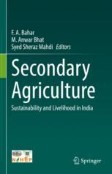Search
Search Results
-
Sustainable pest management in cabbage using botanicals: Characterization, Effectiveness and Economic Appraisal
Mustard aphid, Lipaphis erysimi (Kalt.), diamondback moth, Plutella xylostella (Linn.), and cabbage butterfly, Pieris brassicae (Linn.), were...

-
Legislative situation of botanicals used in plant protection in the European Union
Compounds obtained from plant material may be effective against different groups of pests and can be used in plant protection. Their use in...
-
Efficacy of Botanicals and Bio-pesticides for the Management of Pest Complex of Potato during Post-rainy Season in Karnataka, India
The field experiments were conducted in a randomised block design during two consecutive rabi seasons of 2016–17 and 2017–18 to evaluate the effect...
-
Role of Botanicals in Pest Management in Horticultural Crops
Botanical pesticides are obtained naturally from plant-based chemicals. They are found to be an effective alternative to conventional pesticides....
-
Zum Verzehr ungeeignete Botanicals wie Cannabis und Kurkuma in Lebensmitteln – Anwendung des § 12 LFGB in Abgrenzung von Artikel 14 der Basis-Verordnung
The assessment of foods containing botanicals above toxicological thresholds poses challenges, as administrative court decisions have set high...

-
Seed Priming Through Fungicides, Biocontrol Agents and Botanicals as Effective Method for Controlling Spot Blotch Pathogen, Bipolaris sorokiniana in Barley
This study was carried out to investigate the efficacy of fungicides (mancozeb/carbendazim), biocontrol agents ( Trichoderma viride / Trichoderma...

-
Effects of Botanicals on Growth and Phytochemistry of the Nematode-Infected Pelargonium sidoides and GC–MS Profiling of Cucurbita maxima Seeds
Pelargonium sidoides (African geranium) is recognised by South African traditional healers and the pharmaceutical industry for its medicinal...

-
Green synthesis of nanoparticles using botanicals and their application in management of fungal phytopathogens: a review
Green synthesis of nanoparticles is an emerging aspect in plant disease management that blends nanotechnology and plant-derived ingredients to...

-
Studies on genetic variability and sensitivity of fungicides, botanicals and microbial pesticides in Mycogone perniciosa Magn. causing wet bubble disease (WBD) of button mushroom
IntroductionWet bubble disease or WBD (M. perniciosa) is worldwide problem of button mushroom cultivation. Underfavourable environmental conditions...

-
Integrated management of Meloidogyne incognita on tomato using combinations of abamectin, Purpureocillium lilacinum, rhizobacteria, and botanicals compared with nematicide
BackgroundAcceptable alternative eco-friendly tools in the present study were tested to control the root-knot nematode, Meloidogyne incognita , on...
-
Potential of Botanicals for Wood Protection
The current concern in the field of wood protection is to replace the use of toxic chemicals with natural means of wood protection. Initiatives have...
-
Application of Some Botanicals in the Protection of Sorghum Grains Against the Maize Weevil, Sitophilus zeamais Motsch. (Coleoptera: Curculionidae)
Laboratory studies were conducted in order to assess the ability of Euphorbia balsamifera Aiton, Lawsonia inermis L., Mitracarpus hirtus (L.) DC and Se...

-
Role of Botanicals in Integrated Pest Management for Sustained Crop Production
The crisis of food to feed the increasing human population diverted scientific attention concerning manufacture and advocacy of poisonous man-made...
-
North American Fertility–Regulating Botanicals: a Review
Species from over a hundred genera found in North America have reported traditional uses as contraceptives or uses that suggest possible...
-
Use of botanicals in root-knot nematode control: a meta-analysis
This meta-analysis was conducted to quantitatively analyze the efficacy of plant residues and plant derivatives of various plant species against...

-
The biological effects of microencapsulated organic acids and botanicals induces tissue-specific and dose-dependent changes to the Gallus gallus microbiota
BackgroundMicroencapsulated organic acids and botanicals have the potential to develop into important tools for the poultry industry. A blend of...

-
Management of Lycoriella ingenua (Diptera: Sciaridae) on oyster mushroom (Pleurotus ostreatus) through different botanicals
Oyster mushroom cultivation may be adversely affected by insect pests, including dark-winged fungus gnats, Lycoriella ingenua Dufour. The experiment...
-
Field evaluation of horticultural mineral oils and botanicals against bean thrips, Megalurothrips distalis (Karny) (Thysanoptera: Thripidae), in summer mung bean
BackgroundBean thrips, Megalurothrips distalis (Karny), are a serious insect pest of mung bean grown in summer season as a catch crop in wheat–rice...
-
Biological repercussions of addition of botanicals to wheat grains on the progeny and damage potential of rice weevil (Sitophilus oryzae L.) at different temperature regimes
The management of stored-grain insects, including the rice weevil Sitophilus oryzae , is a challenge to ensure sound healthy grains. Botanical...

